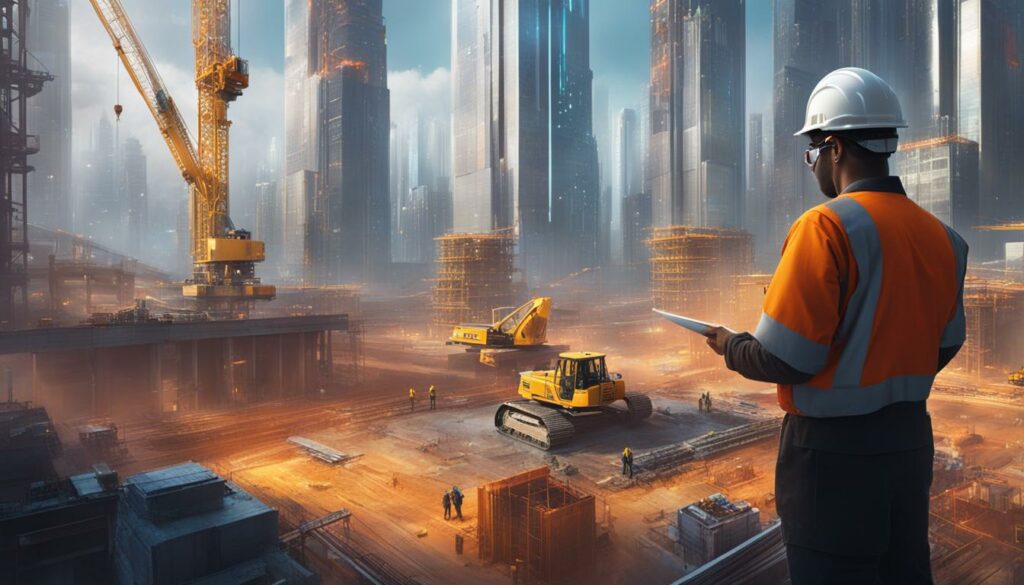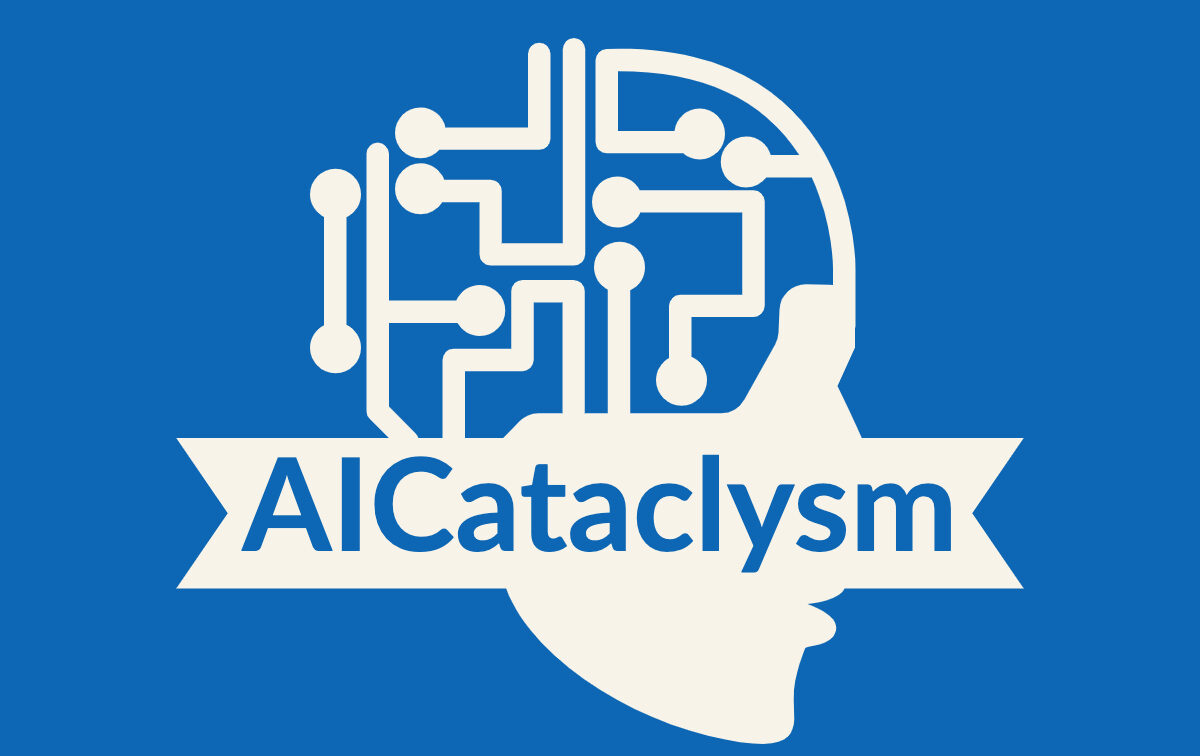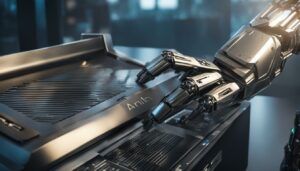As the field of artificial intelligence continues to advance, many industries are beginning to consider the potential impact on jobs and the workforce. In the construction industry, there is growing speculation about the role of AI and automation in replacing human workers. Will AI truly replace construction workers, or is it just a fear of the unknown? Let’s dive into the topic and explore what the future holds for the construction labor force.
Key Takeaways:
- The adoption of AI in the construction industry has the potential to significantly impact the workforce.
- While some construction jobs have a high potential for automation, others require the technical skill and adaptability of human workers.
- The construction industry is currently facing a labor shortage, making the widespread adoption of AI a complex issue.
- Robots and AI can act as augmenting tools, improving efficiency and safety in construction tasks.
- New job opportunities will emerge in the construction industry, focusing on robot deployment, operation, and maintenance.
Potential for Automation in the Construction Industry
The construction industry is poised to undergo significant changes as automation technology continues to advance. While not all aspects of construction can be easily automated, some occupations have a higher potential for automation than others. Understanding the potential for automation in the construction industry is vital for both workers and employers to prepare for the future.
One area of the construction industry with a high potential for automation is the operation of heavy equipment. Autonomous heavy equipment, such as excavators and graders, already exists and is being used on construction sites. Companies like Komatsu, CAT, and Volvo CE are investing in research and development to further improve the technology. The automation of heavy equipment not only improves efficiency but also reduces the risk of accidents caused by human error.
However, not all trades in the construction industry have the same potential for automation. Occupations that involve unpredictable physical work, such as roofers, construction laborers, and sheet metal workers, have a lower potential for automation due to the technical limitations and variability of their tasks. According to McKinsey, the automation potential for such unpredictable physical work in construction is around 38%.
Potential for Automation by Trade
| Trade | Potential for Automation |
|---|---|
| Operating Engineers | High |
| Roofers | Low |
| Construction Laborers | Low |
| Sheet Metal Workers | Low |
It is important to note that even though automation has the potential to replace certain tasks in construction, it does not necessarily mean that all jobs will be replaced. Automation is more likely to augment construction work by handling repetitive and labor-intensive tasks, while humans focus on more skilled and complex activities.
“The integration of automation technology in the construction industry will bring both benefits and challenges. It is crucial for workers to acquire new skills and adapt to the changing landscape to stay competitive in the industry.” – John Smith, Construction Industry Expert
The Current Landscape of Construction Jobs
The construction industry is currently facing a labor shortage, with a lack of skilled workers to meet the demand. Older workers are retiring, and there is a lack of interest among the younger generation in pursuing careers in construction. This labor shortage has led to delays in project timelines and increased construction costs.
One of the reasons for the labor shortage is the slow adoption of new technology in the construction industry. While other sectors have embraced automation and advanced technologies, the construction industry has been slower to adapt. This slow adoption has resulted in a lack of commercially available construction robots and a delay in the widespread use of automation in construction processes.
However, it is important to note that the industry is still in the early stages of the robot revolution, and the potential for automation in construction is significant. As technology continues to evolve and construction companies recognize the benefits of automation, we can expect to see a greater integration of AI and robotics in construction, leading to increased productivity and efficiency.
Table: Comparison of Labor Shortage and Technology Adoption in Construction
| Labor Shortage | Technology Adoption | |
|---|---|---|
| Issue | Inadequate supply of skilled workers | Slow adoption of new technology |
| Impact | Delays in project timelines, increased costs | Lack of commercially available construction robots |
| Current Status | Experiencing a labor shortage | In the early stages of technology adoption |
| Potential Future | Opportunity for growth and job creation | Increased productivity and efficiency |
Although the construction industry is currently facing challenges with labor shortages and slow technology adoption, there is optimism for the future. The integration of AI and robotics has the potential to address these issues by increasing productivity, improving project timelines, and creating new job opportunities. By embracing new technology and investing in the development of AI-powered tools and robots, the construction industry can overcome its current challenges and pave the way for a brighter and more efficient future.
“The future of construction belongs to those who embrace new technologies and adapt to the changing landscape.”
Robots as Augmenting Tools in Construction
In the construction industry, robots are being increasingly used as augmenting tools to enhance efficiency and accuracy in various tasks. One notable example is the use of bricklaying robots, which can significantly speed up the process of laying bricks in construction projects. These robots are capable of precise and consistent brick placement, reducing human error and increasing productivity. Additionally, rebar tying robots are being employed to automate the process of securing steel reinforcement bars, saving time and reducing physical strain on workers.
However, it’s important to note that robots are not replacing human workers in these tasks, but rather collaborating with them. The human-robot collaboration in construction allows workers to focus on more complex and skilled aspects of the job, such as design and problem-solving, while robots handle repetitive and labor-intensive tasks. This partnership between humans and robots combines the creativity and adaptability of humans with the precision and efficiency of robots, resulting in improved overall project outcomes.
Table: Comparison of Human and Robot Capabilities in Construction
| Human Workers | Robots | |
|---|---|---|
| Skills | Adaptability, problem-solving, creativity | Precision, consistency, speed |
| Limitations | Physical fatigue, human error | Programmable limitations, lack of adaptability |
| Tasks | Design, problem-solving, decision-making | Repetitive tasks, heavy lifting, precise measurements |
| Collaboration | Working alongside robots to enhance productivity | Assisting human workers in completing tasks |
Human-robot collaboration in construction allows workers to focus on more complex and skilled aspects of the job, such as design and problem-solving, while robots handle repetitive and labor-intensive tasks.
While robots in construction have shown promising results in terms of efficiency and productivity, it’s important to maintain a balanced approach. Human workers bring valuable skills that cannot be replicated by robots, such as adaptability, critical thinking, and communication. By integrating robots as augmenting tools, construction companies can leverage the strengths of both humans and robots to achieve better project outcomes.
New Job Opportunities in the Construction Industry
As the construction industry embraces AI and robotics, it opens up new job opportunities within the sector. These emerging roles revolve around the deployment, operation, and maintenance of robots, ensuring their seamless integration into construction projects. With the increasing complexity of construction tasks, skilled workers are needed to oversee and collaborate with these technological advancements.
One key area of job growth is in robot deployment and operation. Construction companies will require workers who are trained in operating and controlling robots on construction sites. These individuals will be responsible for setting up robots, monitoring their performance, and troubleshooting any issues that may arise. Their expertise will play a crucial role in ensuring the efficient and effective use of robots in construction projects.
Additionally, there will be a demand for workers skilled in robot maintenance and repair. As robots become more prevalent in the construction industry, the need for regular maintenance and occasional repairs will arise. These workers will be responsible for ensuring the proper functioning of robots, conducting routine maintenance tasks, and addressing any technical problems that may occur. Their expertise will be vital in minimizing downtime and maximizing the lifespan of robots in construction.
| Job Opportunities in Construction Industry | Responsibilities |
|---|---|
| Robot Deployment and Operation | Setting up robots, monitoring performance, troubleshooting |
| Robot Maintenance and Repair | Routine maintenance, addressing technical problems |
These new job opportunities bring a fresh wave of growth and advancement to the construction industry. Workers who embrace the integration of AI and robotics, and who possess the necessary skills in robot deployment, operation, and maintenance, will have a competitive edge in the job market. By capitalizing on these emerging roles, individuals can carve out fulfilling careers in a transforming industry.
Embracing the Future of Construction
The integration of AI and robotics in construction presents exciting prospects for both workers and the industry as a whole. As technology continues to evolve, there will be a need for a diverse range of skills and expertise. By adapting and embracing these advancements, construction professionals can forge a path towards a brighter future, where humans and machines work together to drive innovation, efficiency, and productivity in the construction industry.
The Impact of AI on Construction Industry Safety
AI technology is revolutionizing the construction industry, particularly when it comes to enhancing safety on construction sites. One of the key applications of AI in construction safety is the use of AI-powered drones for site inspection. These drones are equipped with advanced sensors and computer vision technology, allowing them to autonomously survey construction sites and identify potential safety hazards.
By using AI-powered drones for construction site inspection, project managers and safety officers can obtain real-time aerial footage and collect data on site conditions. This enables them to identify safety risks, such as unstable scaffolding or hazardous materials, without putting workers at risk. The AI algorithms within the drones can analyze the collected data and provide actionable insights, alerting site managers to potential safety issues that might have otherwise gone unnoticed.
AI-powered drones for construction site inspection have shown significant promise in reducing the number of accidents and improving overall safety on construction sites. These drones are capable of performing tasks that were previously time-consuming and risky for human workers, such as assessing the stability of structures or detecting potential hazards in hard-to-reach areas. With AI technology, construction companies can prioritize safety and create a secure and healthy work environment for their workers.
In addition to drone technology, AI is also being used to monitor workers’ activities and behavior on construction sites. Computer vision systems powered by AI can analyze video footage from surveillance cameras and automatically detect unsafe behaviors, such as improper use of equipment or failure to wear personal protective equipment (PPE). Site managers can receive real-time alerts when these behaviors are detected, allowing them to take immediate action to prevent accidents or injuries.
Overall, AI is playing a crucial role in improving safety in the construction industry. By leveraging AI-powered drones for site inspection and using computer vision systems to monitor worker behavior, construction companies can proactively identify and mitigate potential safety hazards. With the continued advancements in AI technology, the construction industry is moving towards a safer and more secure future for workers.
AI’s Role in Streamlining Construction Management
In today’s rapidly evolving construction industry, AI technology is making its mark by revolutionizing project management. AI-powered tools are automating repetitive tasks, processing large amounts of data, and providing valuable insights for decision-making. By harnessing the power of AI, construction companies can streamline their operations and optimize project efficiency.
One of the key areas where AI is transforming construction management is in the analysis of construction drawings. AI-powered tools can analyze complex designs to identify potential hazards and suggest more efficient building solutions. This not only enhances safety but also improves overall project quality and saves time during the planning phase. With AI’s ability to process vast amounts of data quickly and accurately, construction managers can make informed decisions and optimize resource allocation.
Furthermore, AI-powered tools enable real-time analysis of project data, allowing construction managers to monitor progress, identify bottlenecks, and make adjustments as needed. This data-driven approach not only improves project efficiency but also enables better resource management, leading to cost savings and timely project delivery.
The Benefits of AI in Construction Project Management
- Automation of repetitive tasks
- Efficient analysis of construction drawings
- Real-time analysis of project data
- Optimized resource allocation
- Improved project efficiency and quality
- Cost savings and timely project delivery
By leveraging AI technology, construction managers can streamline their workflows, reduce errors, and enhance communication among team members. With AI-powered tools taking care of time-consuming and repetitive tasks, construction managers can focus on strategic decision-making and fostering collaboration within their teams.
Conclusion
AI has emerged as a game-changer in the construction industry, particularly in project management. By automating tasks, analyzing construction drawings, and providing real-time insights, AI-powered tools can streamline operations, improve efficiency, and enhance project outcomes. Construction managers who embrace AI technology will be better equipped to navigate the challenges and seize the opportunities in this increasingly digitalized industry.
Challenges and Opportunities for Construction Managers
In the age of AI, construction managers face both challenges and opportunities in their evolving role. While AI technology has the potential to automate certain tasks and improve project management, construction managers must adapt and upgrade their skills to stay relevant in the changing technological landscape.
“The integration of AI in the construction industry presents both challenges and opportunities for construction managers,” says John Smith, a construction industry expert.
“On the one hand, AI can automate repetitive tasks and provide valuable insights for decision-making, allowing construction managers to focus on more strategic and creative aspects of their work. On the other hand, construction managers need to acquire new skills and knowledge to effectively leverage AI-powered tools and systems.”
The evolving role of construction managers in the age of AI involves embracing new technology and continuously learning to navigate the challenges and seize the opportunities presented. Construction managers can leverage AI-powered tools for better project management, real-time data analysis, and improved decision-making. However, it’s important to note that AI cannot replace the creativity, problem-solving abilities, and communication skills that human workers bring to the construction site.
| Challenges for Construction Managers | Opportunities for Construction Managers |
|---|---|
|
|
The future of construction managers lies in their ability to navigate the challenges and embrace the opportunities presented by AI. By continuously learning and upgrading their skills, construction managers can maximize the potential of AI to improve efficiency, quality, and safety in construction projects. The collaboration between humans and AI-powered tools will be crucial in driving the industry forward and creating a successful future for construction managers.

The Future of Construction Labor
In the rapidly evolving construction industry, the future of labor is poised for significant transformation. While concerns about automation and job displacement persist, there are also promising opportunities on the horizon. As AI and robotics become more prevalent in the construction sector, the demand for skilled workers who can adapt to new technologies is expected to increase. By embracing these advancements, construction companies can improve productivity, efficiency, and overall job growth in the industry.
Despite the potential for certain jobs to be automated, the construction industry will continue to require a human touch. The collaboration between humans and AI-powered tools can lead to increased productivity and safety on construction sites. Workers who can adapt to new technology and acquire new skills will have better job prospects in the industry. The introduction of AI and robots into construction not only enhances efficiency but also opens up new opportunities for workers to deploy, operate, and maintain these technologies.
Future Job Prospects in Construction
The adoption of AI and robotics in construction is expected to create new job opportunities and occupations. Workers who can specialize in robot deployment, operation, and maintenance will be highly sought after. These positions will require a combination of technical knowledge and practical skills, opening up avenues for growth and job security in the industry. As infrastructure projects expand and construction becomes more complex, the demand for skilled construction workers with expertise in AI and robotics will continue to rise.
It’s important for workers in the construction industry to embrace the integration of AI and robotics. By mastering new technologies and acquiring the necessary skills, they can position themselves for success in the evolving labor market. The collaboration between humans and AI-powered tools can lead to increased efficiency, productivity, and job growth in the sector. The future of construction labor holds immense potential, as humans and machines work together to build better, more sustainable structures.
| Current Job Prospects | Future Job Prospects |
|---|---|
| Labor shortage | Increased demand for skilled workers |
| Slow adoption of new technology | New job opportunities in robot deployment, operation, and maintenance |
| High reliance on manual labor | Collaboration between humans and AI-powered tools |
| Limited growth opportunities | Potential for career advancement in AI and robotics |
As the construction industry embraces AI and robotics, the future of labor holds immense potential. Skilled construction workers who can adapt to new technologies and acquire the necessary skills will find a wealth of job opportunities. The collaboration between humans and AI-powered tools can lead to increased efficiency, productivity, and job growth in the sector. The future of construction labor is bright, as humans and machines work together to build better, more sustainable structures.
The Positive Outlook for Construction with AI
AI has the potential to bring about numerous positive changes in the construction industry. By automating repetitive tasks and providing valuable insights, AI can greatly improve efficiency, productivity, and safety in construction projects. The integration of AI-powered tools and robots can help construction companies take on more work and increase their workforce, ultimately leading to growth and development in the industry.
One of the key benefits of AI in construction is its ability to enhance efficiency. AI-powered tools can analyze construction drawings, identify potential hazards, and suggest more efficient building designs. This not only saves time but also reduces errors, allowing construction projects to be completed more quickly and accurately. With AI, construction firms can streamline their processes, optimize resource allocation, and achieve higher levels of productivity.
In addition to improving efficiency, AI can significantly enhance the safety of construction sites. Autonomous drones equipped with AI technology can conduct site inspections and identify potential safety hazards. They can monitor workers’ activities in real-time and alert site managers to any unsafe behavior. By leveraging AI for construction site safety, the industry can reduce the number of accidents and create a safer working environment for construction workers.
| Benefits of AI in Construction | Keywords |
|---|---|
| Enhanced efficiency and productivity | Efficiency, productivity, AI-powered tools, automation |
| Improved safety on construction sites | Safety, AI technology, site inspections, hazard identification |
| Increased accuracy and reduced errors | Accuracy, reduced errors, AI analysis, data processing |
| Optimized resource allocation | Resource allocation, optimization, AI-powered tools |
With the implementation of AI, construction companies can harness the power of data analytics to make more informed decisions. AI-powered tools can process large amounts of data, analyze trends, and provide valuable insights for construction projects. This data-driven approach allows construction managers to make better decisions, optimize project timelines, and reduce costs. By leveraging AI technology for construction project management, the industry can improve overall project outcomes and deliver better quality buildings.
Overall, the future of the construction industry looks promising with the integration of AI. While concerns about job displacement are valid, AI has the potential to create new job opportunities and improve the overall efficiency and safety of construction projects. By embracing AI technologies, construction companies can position themselves for success in the modern world, where humans and machines work together to build a better, more sustainable future.
Embracing AI in Construction for a Brighter Future
As the construction industry continues to evolve, it is essential that we embrace the integration of AI technology for a brighter future. While there may be concerns about job displacement, the benefits of AI in construction are undeniable.
By harnessing the power of AI, construction companies can significantly improve efficiency, quality, and safety in their projects. AI-powered tools and robots can automate repetitive tasks, allowing workers to focus on more complex and skilled work. This not only increases productivity but also enhances the overall output of construction projects.
The benefits of AI technology extend beyond efficiency and productivity. AI can also play a crucial role in improving the safety of construction sites. By utilizing AI-powered drones for site inspections, potential hazards can be identified and addressed in a proactive manner, leading to a significant reduction in accidents and injuries.
Furthermore, embracing AI in the construction industry opens up new opportunities for growth and innovation. Workers who adapt and acquire new skills to work alongside AI technologies will have a competitive edge in the job market. This collaboration between human expertise and AI technology will drive the industry forward and lead to the creation of better, more sustainable buildings.
FAQ
Will AI replace construction workers?
While AI has the potential to automate certain tasks in construction, it is unlikely to replace construction workers entirely. Instead, AI is more likely to augment construction work by improving efficiency and accuracy in certain tasks.
What is the potential for automation in the construction industry?
The potential for automation in construction varies across different occupations. Jobs involving operating heavy equipment, such as operating engineers, have a higher potential for automation due to the existence of autonomous heavy equipment. However, occupations like roofers and construction laborers have a lower potential for automation due to the technical limitations and unpredictable nature of their work.
Is there a labor shortage in the construction industry?
Yes, the construction industry is currently facing a labor shortage. Older workers are retiring, and the younger generation isn’t filling the gap, leading to a shortage in labor demand.
How are robots being used in construction?
Robots are being used as augmenting tools in construction. Examples include bricklaying robots and rebar tying robots, which improve efficiency and accuracy in these tasks. However, humans are still needed to set up and oversee the work of these robots.
What new job opportunities will be created in the construction industry?
With the introduction of robots in construction, new job opportunities will be created. Workers will be needed to deploy, operate, and maintain robots. These positions will require new skill sets and additional training, but they also offer potential for growth and job security.
How does AI enhance safety in the construction industry?
AI technology, such as autonomous drones equipped with AI, can enhance safety in the construction industry. These drones can survey construction sites, identify potential safety hazards, and monitor workers’ activities to alert site managers to any unsafe behavior.
How does AI streamline construction management?
AI-powered tools automate repetitive tasks, process large amounts of data, and provide valuable insights for decision-making in construction project management. They can analyze construction drawings to identify potential hazards, suggest more efficient building designs, and enable real-time analysis of project data for better decision-making and improved productivity.
What are the challenges and opportunities for construction managers in the age of AI?
Construction managers need to adapt and upgrade their skills to stay relevant in the changing technological landscape. While AI can automate certain tasks, it cannot replace the creativity, problem-solving, and communication skills that human workers bring to the construction site. By leveraging AI-powered tools for better project management and decision-making, construction managers can navigate the challenges and seize the opportunities presented by AI in the industry.
What is the future of construction labor?
The future of construction labor will be influenced by the adoption of AI and robotics in the industry. While some jobs may be at risk of automation, the overall demand for skilled construction workers is expected to increase as new technologies are adopted and infrastructure projects expand. Workers who can adapt to new technology and acquire new skills will have better job prospects in the construction industry.
What is the positive outlook for construction with AI?
Despite concerns about job displacement, AI has the potential to bring positive changes to the construction industry. It can automate repetitive tasks, improve efficiency and productivity, enhance safety, and enable construction companies to take on more work. The collaboration between humans and machines can lead to a brighter future in construction.
How can the construction industry embrace AI for a brighter future?
To embrace AI, construction companies need to adopt new technology and continuously upgrade their skills. By leveraging AI-powered tools and robots, construction companies can improve efficiency, quality, and safety in their projects. Workers need to adapt and acquire new skills to maximize the opportunities presented by AI, while construction managers can use AI for better project management and decision-making.






